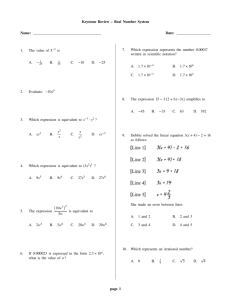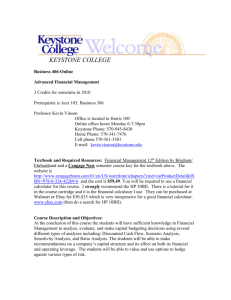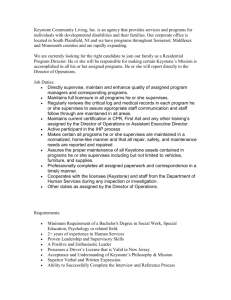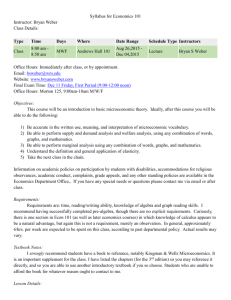Business 340 Online
advertisement
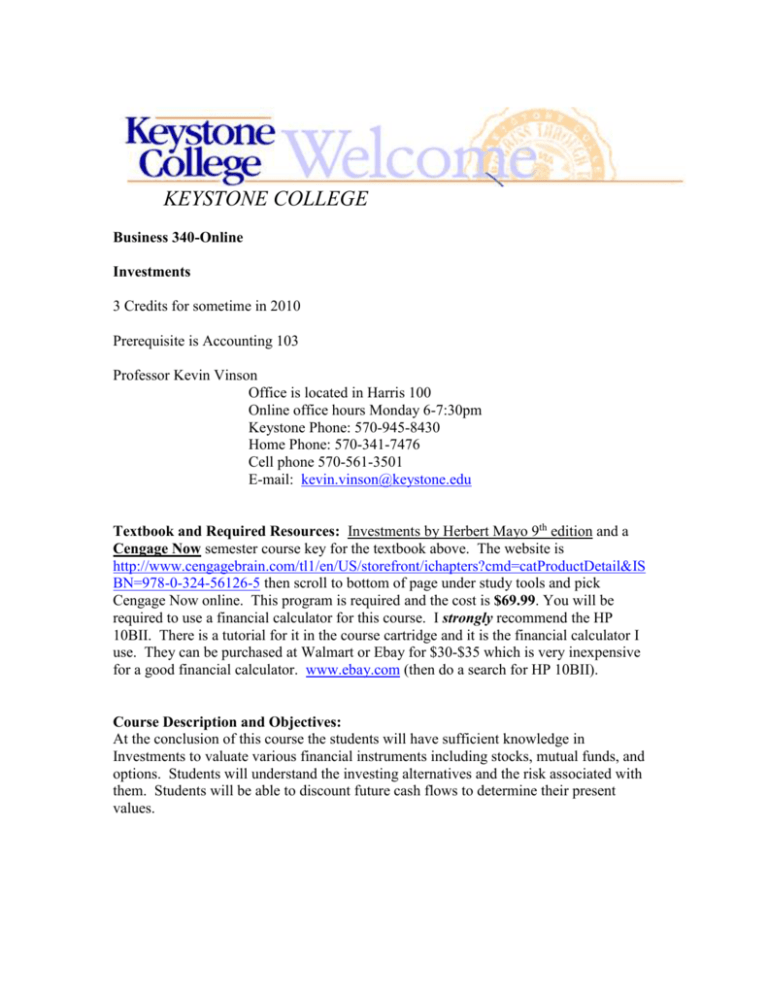
KEYSTONE COLLEGE Business 340-Online Investments 3 Credits for sometime in 2010 Prerequisite is Accounting 103 Professor Kevin Vinson Office is located in Harris 100 Online office hours Monday 6-7:30pm Keystone Phone: 570-945-8430 Home Phone: 570-341-7476 Cell phone 570-561-3501 E-mail: kevin.vinson@keystone.edu Textbook and Required Resources: Investments by Herbert Mayo 9th edition and a Cengage Now semester course key for the textbook above. The website is http://www.cengagebrain.com/tl1/en/US/storefront/ichapters?cmd=catProductDetail&IS BN=978-0-324-56126-5 then scroll to bottom of page under study tools and pick Cengage Now online. This program is required and the cost is $69.99. You will be required to use a financial calculator for this course. I strongly recommend the HP 10BII. There is a tutorial for it in the course cartridge and it is the financial calculator I use. They can be purchased at Walmart or Ebay for $30-$35 which is very inexpensive for a good financial calculator. www.ebay.com (then do a search for HP 10BII). Course Description and Objectives: At the conclusion of this course the students will have sufficient knowledge in Investments to valuate various financial instruments including stocks, mutual funds, and options. Students will understand the investing alternatives and the risk associated with them. Students will be able to discount future cash flows to determine their present values. Goals for Business 340 Students will: A. Understand the relationship between risk and return. B. Understand the different types of securities as well as the short selling process. C. Understand the different types of mutual funds and the underlying fees associated with each type. D. Understand the affect of taxes on investment decisions E. Distinguish between the primary and secondary markets as well as the different indexes. F. Understand the different types of options and their valuation. Objectives for Business 340 Your objectives in the course are to prove that you are competent to: 1. Analyze the factors that affect a stock’s price. 2. Choose among various investment decisions factoring in the tax consequence of each one. 3. Calculate the value of options and use them to hedge different types of risk. 4. Create a diversified portfolio aligned with an individual’s risk tolerance. Assessments Homework assignments Exams Discussion Posts/Questions Internet Assignments/Case Studies Goals ABCDEF ABCDEF ABCDEF ABCDEF Objectives 1,2,3,4 1,2,3,4 1,2,3,4 1,2,3,4 Welcome to Business 340 Online For those of you who are new to online learning I would like to spend a little time discussing our new classroom. The main place where we meet each other is in the GENERAL DISCUSSION BOARD. We will post answers to our assigned questions on a specific discussion board entitled HOMEWORK. It is on this board that we will also post comments and or questions to the answers provided. It is this board entitled HOMEWORK that will be part of your final grade. We will have a different discussion board (General) to post everything else including but not limited to information about ourselves and our interests, general questions and answers pertaining to the class (but NOT questions or comments on the assigned essay type questions). This is a cyberspace classroom and we must be extra careful to make sure we address everyone with the respect and consideration we ourselves would like to be shown. We need to know that certain rules will be followed and everyone will be safe to express themselves. There are rules of etiquette that people in polite societies follow and we will also discuss netiquette. (Etiquette for the Internet.) I would like to propose some rules for our cyberspace classroom. Many of you use shorthand when communicating online. I am speaking of BRB which means be right back or maybe a character display like , to express a smile. This is a new type of language. As you read the syllabus you will note that posting your answers and comments to the HOMEWORK discussion board is a portion of your grade in this course. I expect you to become a valued member of this online community and in order to do that you must attend class and post material on the discussion board in a timely manner. I like to run a casual class...so I think abbreviations are OK in speaking with one another. However, when answering the required questions on the HOMEWORK board proper grammar and spelling is required. Please start with the tab on blackboard START HERE to make sure you can use all the tools required for our class. After properly loading the course cartridge and course key please complete the orientation found in the ORIENTATION tab. Class Resources There are two different sites you will be using for this course. The first is blackboard where the two discussion boards are located. In blackboard you can click on Course Documents and find the power points for all 9 chapters. You can open them in blackboard and scroll down them using the mouse but you will not see all of power points on the left. I therefore recommend you save them to your desktop where you can then view them in the usual manner. To do this you 1. Right click the power point chapter you want to view. 2. Then select “save target as”. 3. Then choose your desktop and it will save to your desktop for easy viewing. Cengage Now has a calculator tutorial which I strongly recommend everyone go through before attempting any homework assignments. I have it posted on Blackboard. To access it 1. Login to Cengage Now, (email and password). Do not pick the SSO Cengage Now for this textbook as you normally would to access the course. Instead pick the “students companion website” (it is below the SSO Cengage now option). 2. Under book resources choose the “calculator tutorial” then chose the HP 10BII calculator assuming you have one. Once you are logged into the course there are various resources for you to access to help you throughout the semester. NOTE YOU MUST HAVE YOUR POP-UP BLOCKER OFF at all times when you are in the course to allow course resources to run. To find them 1. Click on the “assignments” icon 2. Then select Practice Chapter you are on. 3. Take the pre-test. Afterwards a personalized study plan will be available to you. It will show your areas of weakness. Note the pre-test does not count towards your grade. It is the post-test that counts towards your grade but you can take it up to 4 times to help improve your grade. 4. After taking the pre-test there is an icon to the left under option 2 (Study Plan) that says ALL CHAPTER CONTENT. Click on it to see the areas you need to focus on based on the pre-test. I also encourage students to review the New Student Blackboard Orientation tutorial before the start of classes to resolve any “technical issues” early on. See the Online Learning web page, FAQ’s at the following link http://www.keystone.edu/about_us/departments_and_offices/faqs.dot?inode=79671&cru mbTitle=Online%20Learning%20FAQ's There is nothing worse than that late for class feeling….especially if you can’t find the classroom. You can get technical support or assistance by contacting IT Helpdesk by phone (570) 945-8778 or helpdesk@keystone.edu For Blackboard assistance http://blackboard.keystone.edu/ or e-mail the Blackboard administrator at blackboard@keystone.edu For many helpful student resources go to: http://www.keystone.edu/onlinelearning/studentresources Student Expectations Online students will be completing online assignments in the form homework, tests, and answering questions and posts in response to the questions in the discussion board HOMEWORK each week/module. Most online students say the most important thing about taking an online class is to set aside time each week to work on the class assignments, just as you would in a regular classroom. You know all of your assignments and their various due dates ahead of time so please prepare/budget your time accordingly. Assignments must be completed by the corresponding due dates to receive credit. It is easy to fall behind and very difficult to catch up. In this course you will probably not be able to work ahead and get all of your course work completed in a shorter time frame because there is a discussion board component that requires weekly submissions. You will be able to work ahead by doing your homework and tests assignments ahead of time as they are all available upon entrance to the class. Do not expect that you can work on this class at your leisure. There are usually 3 assignments and various end of chapter questions for each of the 9 chapters plus Internet Assignments/Case Studies for various chapters. This is a complex subject matter and reading, studying and homework will require extensive amounts of time just as it does in a traditional classroom environment. Most people are busy and choose online to fit education into an already busy life. Deadlines are set for class questions and the corresponding posts required by everyone in the class. As stated earlier all assignments, questions and tests must be submitted by the specified due date to receive credit. Make sure you set aside time and make a schedule that works for you to follow the due dates. I am not the only one who answers the questions in general discussion thread. I can, at my discretion award extra points at the end of the semester for students who have been helpful in answering others questions as this can greatly enhance the learning process. The board can be a great source for nearly instant help and support; someone is often online and working at the same time. I will be posting answers to students’ questions as well as some sample problems throughout the semester so please keep your eye on the discussion board. Midterm and Final grades are determined using the Keystone Grading Policy. Letter grade A AB+ B BC+ C CD+ D F Numeric Equivalent 4.0 3.67 3.33 3.0 2.67 2.33 2.0 1.67 1.33 1.0 0.0 Percentage of total 95-100 90-94 87-89 84-86 80-83 77-79 74-76 70-73 65-69 60-64 0-60 Please note that the assignments labeled “Practice” are in fact graded and part of your grade (aside from the first one which is extra credit but is a required part of the orientation). Cengage Now automatically grades your homework and tests. It also keeps a running total of your current average and the weights of each assignment. The weekly questions and required posts will be manually graded and will compromise 10% of your final grade. The Internet Assignments/Case Studies will also compromise 15% of your final grade. The Internet Assignments/Case Studies and end of chapter questions are intended to inspire learning and help further develop your analytical skills. These are points that can certainly help your final grade in this challenging course. The grades for these will be put into the grade book on blackboard and then factored into your final average. Please note that end of chapter questions must be answered with clear and concise understanding of the topic posted that week. Finding excerpts from the textbook or textbook resources and incorporating them into the students’ answer make it clear that the student has a full understanding of the class goals. Discussion and/or responses such as “good posts” or “I feel it is important” lack depth and they certainly do not tell the instructor that you are reading the text and corresponding textbook resources. Inability to submit work on time or missing a final exam does not constitute a valid reason for an incomplete grade as described in the course catalog. Please note: Any student with any kind of special need or accommodation that may impair or influence participation in the activities of this course should notify the course instructor as soon as possible. Keystone College does not discriminate in any of its programs on the basis of disability While there is not a deadline for the disclosure of a disability by a student, in order to facilitate the documentation and accommodation processes, students are encouraged to voluntarily and confidentially disclose and disability requiring an accommodation prior to the beginning of class. This disclosure should be made to Owen Conaghan, owen.conaghan@keystone.edu who is the ADA Coordinator. Students who disclose a disability, and who are seeking an\accommodation, ultimately will be expected to provide documentation verifying the disability. Plagiarism & Academic Integrity Academic misconduct and dishonesty includes any activity that compromises the academic integrity of the College or subverts the educational process. For information on dishonest acts including plagiarism, cheating, and fraud, consult your Student Information Guide or click on the link below. If you have any questions, talk with your instructor. http://web.keystone.edu/Library/syllabus/integrity.htm Copyright Notice The copyright law of the United States (Title 17, United States Code) governs the making of photocopies or other reproductions of copyrighted materials, including music and software. Copying, displaying, reproducing, or distributing copyrighted works may infringe the copyright owner’s rights and such infringement is subject to appropriate disciplinary action as well as criminal penalties provided by federal law. Usage of such material is only appropriate when that usage constitutes “fair use” under the Copyright Act. As a Keystone College student, you are required to follow the College’s copyright policy. For more information about the fair use exemption, see the Miller Library’s copyright page: http://web.keystone.edu/library/copyright.html Email Use Keystone College states that all official student email correspondence be sent only to a student’s Keystone email address and that faculty and staff consider email from student’s official only if it originates from a Keystone account. This allows the College to maintain a high degree of confidence in the identity of all individuals and the security of transmitted information. Keystone College furnishes each student with a free email account that is to be used in all communication with College personnel. Withdrawal from Class The College has set deadlines for withdrawing from courses. These dates and times are published in the course catalog and on the Academic Calendar. It is the student's responsibility to handle withdrawal requirements from any class. You must do the proper paperwork to ensure that you will not receive a final grade of "F" in a course if you choose not to attend once you are enrolled. If you are considering withdrawing from a class, talk with your Advisor and consult the College Catalog. Academic Grievance Procedures Procedures for student grievances are found in the College Catalog. Please consult the procedures before taking action. Please note: The first step in attempting to resolve any student grievance regarding grades, evaluations, or other fulfillments of academic responsibility, is to make a serious effort to resolve the matter with the instructor. The College Catalog outlines any subsequent steps. According to the College Catalog, an Incomplete (“I”) will only be awarded in the case of exceptional circumstances. Mere inability to submit work on time, or missing the final exam, is not valid reasons for an Incomplete. Incomplete Grades Students must make arrangements with the instructor prior to the final exam it they wish to receive a grade of incomplete. (Forms are available in the Office of the Registrar.) The deadline for the completion of the coursework is four weeks into the next semester. If the course work is not completed within the specified time frame, the incomplete grade will become an “F.” KC Connect For information about classes & advisers, to check midterm and final grades or to register for classes, logon to KC Connect. Tutoring Info Advising & Other Student Support Info The College does offer tutoring assistance for many courses. For more information or to schedule an appointment, consult the Tutoring webpage here: http://www.keystone.edu/student_life/support_services/tutoring.dot For information about academic advising, visit the Academic Advising Center homepage here: http://www.keystone.edu/about_us/departments_and_offices/detailed.dot?inode=142908& crumbTitle=Academic%20Advising%20Center For a list of Student Support Services, visit the Support Services webpage here: http://www.keystone.edu/student_life/support_services/index.dot Bookstore Info Visit the Bookstore at this link: http://www.bkstr.com/webapp/wcs/stores/servlet/StoreCatalogDisplay?storeId=10117&la ngId=-1&catalogId=10001 Library Info If there are materials on course reserve or other subject specific details, list them here. We will cover 9 chapters over the semester. The following chapters and their corresponding assignments are as followed: Module # Modular Learning Objectives Assignments Module 1 Orientation ____________ Module 2 Chapter 1 Module 3 Chapter 2 ____________ Module 4 Chapter 2 Module 5 Chapter 3 Module 6 Chapter 4 Set up the Cengage Now Program Meet the other members of the class. Post a quick bio on yourself on the General Discussion Board Complete the calculator tutorial described in syllabus under class resources. Complete Practice Chp. 1 _________________________________ _______________________ 1. Distinguish between primary and secondary markets. 2. Understand and identify the sources of risk and return. Retake Practice Chapter 1 upon reading chapter 1 1. Identify the role of the investment banker and the factors necessary for the sale of securities to the general public. 2. Compare the various financial instruments available to investors. ______________________________ End of chapter questions Practice Assignment Chp. 2 1. Track an IPO and monitor its progress. 2. Compare several money market instruments. 3. Explain the underwriting process. Chp. 2 Internet Assignment 1. Differentiate between the different types of security orders and identify their costs. 2. Understand the difference between long and short positions and their potential profit or loss. 3. Understand the purpose of the SEC and the SIPC and the role of regulation in the securities market. End of chapter questions 1. Understand the time value of money. 2. Differentiate between compounding End of chapter questions Chapter 1 Test ______________________ Chapter 2 Test Practice Assignment Chp.3 Chapter 3 Homework Chapter 3 Test Practice Assignment Chp. 4 and discounting. Module 7 Chapter 4 Module 8 Chapter 5 Module 9 Chapter 5 Module 10 Chapter 6 Module 11 Chapter 7 1. Calculate the present and future values of a single sum, annuities, and irregular cash flows. 2. Compare and choose between potential capital investments. Chapter 4 Homework 1. Understand the taxes that affect investment decisions. 2. Understand how capital losses can be used to offset capital gains and ordinary income. 3. Explain the tax advantages of municipal bonds, annuities, and life insurance. End of chapter questions 1. Calculate the marginal tax bracket for different levels of income. 2. Calculate the tax liability of capital gains and dividends. 3. Calculate the tax saving of investing in different types of retirement plans. Chp. 5 Internet Assignment 1. Identify the relationships among securities necessary to achieve diversification in a portfolio. 2. Understand how standard deviations and betas measure risk. 3. Calculate a stock’s expected return using the Capital Asset Pricing Model. End of chapter questions 1. Understand the various costs of investing in mutual funds. 2. Calculate the net asset value of mutual funds. 3. Identify the various factors to End of chapter questions Chapter 4 Test Practice Assignment Chp. 5 Chapter 5 Test Practice Assignment Chp.6 Chapter 6 Test Practice Assignment Chp.7 Chapter 7 Test Module 12 Chapter 9 Module 13 Chapter 9 consider when selecting a mutual fund. 1. Understand the components of an investor’s required rate of return. 2. Identify the factors that affect a stock’s price. 3. Understand the three forms of efficient market hypotheses. 1. Calculate the required rate of return for various stocks. 2. Calculate the expected stock price using the constant growth and constant dividend equations. Module 14 Chapter 19 1. Module 15 Chapter 19 1. Calculate the time and intrinsic value of both call and put options. 2. Understand how to use put options to hedge downside risk. 3. Calculate the profit or loss from writing rather than buying options. End of chapter questions Practice Assignment Chp.9 Chapter 9 Homework Investment Case page 317318 Chapter 9 Test Understand the various types of End of chapter questions options and the risks associated with each one. Practice Assignment Chp 19 2. Understand how a change in the underlying security price affects the price of options. 3. Identify the advantages offered by stock index options. Chapter 19 Homework Chapter 19 Test “This workforce solution was funded by a grant awarded under Workforce Innovation in Regional Economic Development (WIRED) as implemented by the U.S. Department of Labor’s Employment and Training Administration. The solution was created by the grantee and does not necessarily reflect the official position of the U.S. Department of Labor. The Department of Labor makes no guarantees, warranties, or assurances of any kind, express or implied, with respect to such information, including any information on linked sites and including, but not limited to, accuracy of the information or its completeness, timeliness, usefulness, adequacy, continued availability, or ownership. This solution is copyrighted by the institution that created it. Internal use by an organization and/or personal use by an individual for non-commercial purposes is permissible. All other uses require the prior authorization of the copyright owner.”

